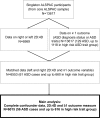Digit ratio and autism spectrum disorders in the Avon Longitudinal Study of Parents and Children: a birth cohort study
- PMID: 26307613
- PMCID: PMC4550720
- DOI: 10.1136/bmjopen-2014-007433
Digit ratio and autism spectrum disorders in the Avon Longitudinal Study of Parents and Children: a birth cohort study
Abstract
Objectives: To investigate whether second-to-fourth digit ratio (2D:4D), a measure commonly used as a proxy for fetal testosterone exposure, is associated with autism spectrum disorders (ASDs), as predicted by the extreme male brain theory of autism.
Design: A birth cohort study.
Setting: The Avon Longitudinal Study of Parents and Children (ALSPAC).
Participants: 6015 ALSPAC children with data on digit ratio, at least 1 outcome measure and information on potential confounding variables (parental occupational class, maternal education and age at digit ratio measurement). Digit ratio was measured by the photocopy and calliper method.
Outcomes: ASD diagnosis (cases were identified previously by record linkage or maternal report) and 4 measures that combine optimally within ALSPAC to predict ASD: the Children's Communication Checklist (coherence subscale), the Social and Communication Disorders Checklist, a repetitive behaviour measure, and the Emotionality, Activity and Sociability scale (sociability subscale). These measures were dichotomised, with approximately 10% defined as the 'risk' group.
Results: Using logistic regression, we examined the association of 2D:4D with ASDs and 4 dichotomised ASD traits. Covariates were occupational class, maternal education and age at 2D:4D measurement. 2D:4D was not associated with ASDs in males (adjusted OR per 1 SD increase in mean 2D:4D, 0.88 (95% CI 0.65 to 1.21), p=0.435) or females (adjusted OR=1.36 (95% CI 0.81 to 2.28), p=0.245). Similar results were observed after adjustment for IQ. There was 1 weak association between reduced coherence and increased left 2D:4D in males, in the opposite direction to that predicted by the extreme male brain theory (adjusted OR=1.15 (95% CI 1.02 to 1.29), p=0.023). Given multiple comparisons, this is consistent with chance.
Conclusions: In this population-based study, there was no strong evidence of an association between 2D:4D and ASD diagnosis or traits, although the CIs were wide. These results are not consistent with the extreme male brain theory.
Keywords: Child & adolescent psychiatry < PSYCHIATRY; Developmental neurology & neurodisability < PAEDIATRICS; EPIDEMIOLOGY.
Published by the BMJ Publishing Group Limited. For permission to use (where not already granted under a licence) please go to http://group.bmj.com/group/rights-licensing/permissions.
Figures


Similar articles
-
Testing the extreme male brain theory of autism spectrum disorder in a familial design.Autism Res. 2014 Aug;7(4):491-500. doi: 10.1002/aur.1384. Epub 2014 Apr 28. Autism Res. 2014. PMID: 24777834
-
Social communication and emotion difficulties and second to fourth digit ratio in a large community-based sample.Mol Autism. 2015 Dec 28;6:68. doi: 10.1186/s13229-015-0063-7. eCollection 2015. Mol Autism. 2015. PMID: 26715984 Free PMC article.
-
2D:4D Ratio and Autism Spectrum Disorder in Brunei Darussalam.J Autism Dev Disord. 2021 Dec;51(12):4577-4586. doi: 10.1007/s10803-021-04899-9. Epub 2021 Feb 11. J Autism Dev Disord. 2021. PMID: 33570687 Free PMC article.
-
Digit ratio 2D:4D in relation to autism spectrum disorders, empathizing, and systemizing: a quantitative review.Autism Res. 2012 Aug;5(4):221-30. doi: 10.1002/aur.1230. Epub 2012 Jun 1. Autism Res. 2012. PMID: 22674640 Review.
-
A critical review of the research on the extreme male brain theory and digit ratio (2D:4D).J Autism Dev Disord. 2013 Nov;43(11):2664-76. doi: 10.1007/s10803-013-1819-6. J Autism Dev Disord. 2013. PMID: 23575643 Review.
Cited by
-
An Inventory of European Birth Cohorts.Int J Environ Res Public Health. 2020 Apr 28;17(9):3071. doi: 10.3390/ijerph17093071. Int J Environ Res Public Health. 2020. PMID: 32354101 Free PMC article.
-
Does testosterone impair men's cognitive empathy? Evidence from two large-scale randomized controlled trials.Proc Biol Sci. 2019 Sep 11;286(1910):20191062. doi: 10.1098/rspb.2019.1062. Epub 2019 Sep 4. Proc Biol Sci. 2019. PMID: 31480979 Free PMC article. Clinical Trial.
-
The Diagnosis and Management of Autism Spectrum Disorder (ASD) in Adult Females in the Presence or Absence of an Intellectual Disability.Int J Environ Res Public Health. 2022 Jan 25;19(3):1315. doi: 10.3390/ijerph19031315. Int J Environ Res Public Health. 2022. PMID: 35162336 Free PMC article. Review.
-
Genetic liability to rheumatoid arthritis on autism and autistic traits: polygenic risk score and Mendelian randomization analyses.Transl Psychiatry. 2022 Jan 12;12(1):18. doi: 10.1038/s41398-021-01772-2. Transl Psychiatry. 2022. PMID: 35022383 Free PMC article.
-
Childhood Trauma As a Mediator of the Association Between Autistic Traits and Psychotic Experiences: Evidence From the Avon Longitudinal Study of Parents and Children Cohort.Schizophr Bull. 2023 Mar 15;49(2):364-374. doi: 10.1093/schbul/sbac167. Schizophr Bull. 2023. PMID: 36434745 Free PMC article.
References
-
- American Psychiatric Association. Diagnostic and Statistical Manual of Mental Disorders (DSM-5) . Arlington, VA: American Psychiatric Publishing, 2013.
-
- Developmental Disabilities Monitoring Network Surveillance Year 2010 Principal Investigators; Centers for Disease Control and Prevention (CDC). Prevalence of autism spectrum disorder among children aged 8 years—autism and developmental disabilities monitoring network, 11 sites, United States, 2010. MMWR Surveill Summ 2014;63:1–21. - PubMed
Publication types
MeSH terms
Substances
Grants and funding
LinkOut - more resources
Full Text Sources
Other Literature Sources
Medical
